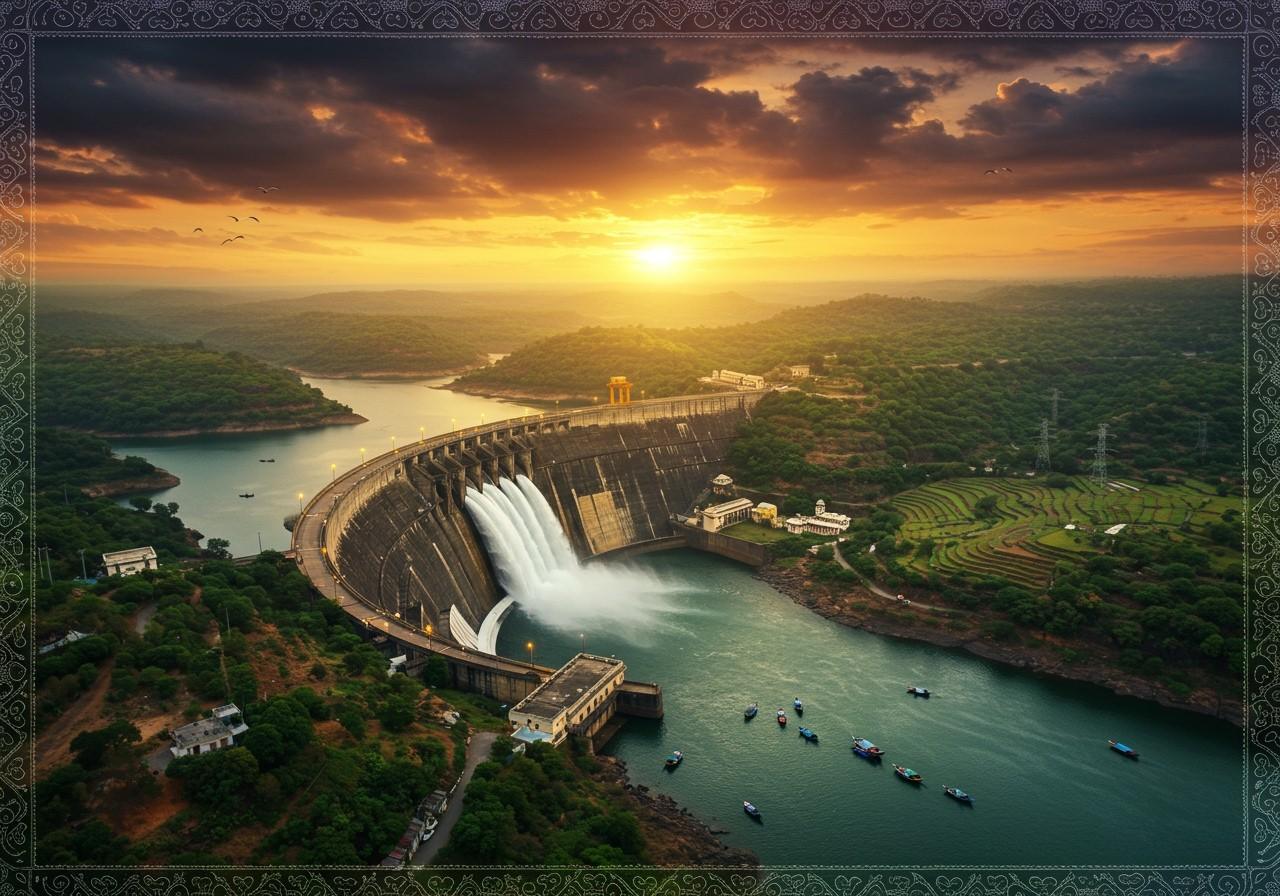
The Tungabhadra Dam stands as a testament to India’s engineering prowess, providing vital resources for both Karnataka and Andhra Pradesh. Located in Hosapete, near the historical site of Hampi, this multipurpose dam harnesses the Tungabhadra River for irrigation, hydroelectric power generation, and drinking water supply. This blog delves into its history, construction, significance, and tourism aspects.
Historical Background
The Tungabhadra River, formed by the confluence of the Tunga and Bhadra rivers, has long been a vital resource. The concept of constructing a dam to harness its potential arose in the early 20th century. The Tungabhadra River Project aimed to address water scarcity and tap into the river’s hydropower potential. Construction commenced in 1945 and concluded in 1953, coinciding with India’s post-independence development. The dam has significantly transformed the agricultural landscape of the region.
An Engineering Marvel
The Tungabhadra Dam exemplifies engineering excellence. Stretching 2,449 meters in length and standing 49.38 meters high, it impounds a vast reservoir capable of holding 3,776 million cubic meters of water. The spillway, equipped with 33 gates, ensures efficient water management. The dam’s robust design, employing gravity and earth-fill methods, guarantees its strength and longevity. The on-site hydroelectric power station generates substantial electricity, fulfilling a significant portion of the region’s energy needs.
Significance and Impact
The Tungabhadra Dam plays a multifaceted role:
- Irrigation: The dam irrigates over 1.2 million acres of farmland, supporting the cultivation of crucial crops like paddy, sugarcane, and cotton, thereby bolstering agricultural productivity and food security.
- Water Supply: It provides a reliable source of drinking water to numerous towns and cities, ensuring access to this essential resource for both domestic and industrial purposes.
- Hydroelectric Power: The dam’s power station generates substantial hydroelectric power, contributing significantly to the region’s electrification and powering industries and homes.
- Flood Control: By regulating water flow, the dam helps mitigate the impact of seasonal floods, protecting communities and infrastructure downstream.
The Tungabhadra River Valley Project
The Tungabhadra River Valley Project encompasses not only the dam itself but also an extensive network of irrigation canals. This comprehensive project aims to optimize water distribution and enhance agricultural output. Canals stretching over 2,500 kilometers deliver water to arid regions, ensuring equitable water access. The project also incorporates weirs, sluices, and channels, further refining water management. Its success has served as a model for similar projects across India.
Tourism at Tungabhadra Dam
Beyond its functional significance, the Tungabhadra Dam is a popular tourist attraction. Its scenic beauty draws visitors seeking respite and recreation. The surrounding park offers lush greenery and picnic spots, providing a tranquil setting for families and nature enthusiasts. Boating on the reservoir provides recreational opportunities, while the nearby town of Hosapete serves as a gateway to the magnificent Vijayanagara ruins at Hampi, a UNESCO World Heritage Site. The dam is beautifully illuminated during festivals, creating a captivating spectacle.
Environmental Considerations
The Tungabhadra Dam, while beneficial, has also had environmental consequences. The creation of the reservoir resulted in the submergence of vast land areas, impacting existing ecosystems. However, ongoing initiatives such as afforestation and wildlife conservation programs aim to mitigate these effects and promote ecological balance. The dam contributes to sustainable water use, crucial for long-term environmental health.
Visitor Information
For up-to-date information, please refer to online search results. Generally, the Tungabhadra Dam offers activities like boating, fishing, bird watching, and picnicking. The park features lovely lawns, a mini zoo, and shuttle buses to various viewpoints. The dam is typically open from 9 AM to 5:30 PM, and a visit of 1-2 hours is recommended.
Poojn.in: Your Source for Sacred Items
The Tungabhadra Dam, a vital water source, also holds spiritual significance for many. For those seeking to perform traditional rituals near water bodies, Poojn.in https://www.poojn.in offers a wide selection of sacred items:
- Narmada Shivling: Ideal for prayers and offerings at sacred locations near the dam. https://www.poojn.in/product/11061/original-athizay-stone-shiva-lingam-and-nandi-set-4-no-4-5-inch-height-shiva-lingam-and-3-inch-long-nandi-bhagaban
- Copper Kalash: A traditional vessel for water-based ceremonies and rituals. https://www.poojn.in/product/11053/pure-copper-snake-9-inch-height-for-8-no-shiva-lingam
- Other Items: Poojn.in also offers a variety of other items such as Gangajal, Brass Deepak, Cotton Wicks, Pure Ghee, Kumkum, Haldi, Coconuts, and Incense Sticks, all essential for traditional rituals and ceremonies. https://www.poojn.in
Poojn.in ensures quality and authenticity, delivering across India with secure packaging. Visit our website or call our toll-free number to order these items for your next visit to the Tungabhadra Dam.
You can find more interesting information about nearby temples on our blog: Virupaksha Temple, Annapoorneshwari Temple, and Veerabhadra Temples.
Conclusion
The Tungabhadra Dam is more than just an infrastructure project; it is a symbol of progress and sustainability, nurturing the land and its people. It stands as a testament to human ingenuity and a vital lifeline for the region. As we marvel at its engineering and appreciate its contribution to the region’s prosperity, let us also acknowledge the importance of balancing development with environmental stewardship.


